
The New World leaf-nosed bats (Phyllostomidae) are bats found from southern North America to South America, specifically from the Southwest United States to northern Argentina. They are ecologically the most varied and diverse family within the order Chiroptera. Most species are insectivorous, but the phyllostomid bats include within their number true predatory species and frugivores. For example, the spectral bat, the largest bat in the Americas, eats vertebrate prey, including small, dove-sized birds. Members of this family have evolved to use food groups such as fruit, nectar, pollen, insects, frogs, other bats, and small vertebrates, and in the case of the vampire bats, even blood.

The Jamaican, common, or Mexican fruit bat is a frugivorous bat species native to the Neotropics.

The big-eared woolly bat or (Peters's) woolly false vampire bat is a species of bat, belonging to the family Phyllostomidae.

The Brazilian big-eyed bat is a species of phyllostomid bat from South America. The scientific name honours Italian naturalist Giacomo Doria.

Micronycteris is a genus of leaf-nosed bats.
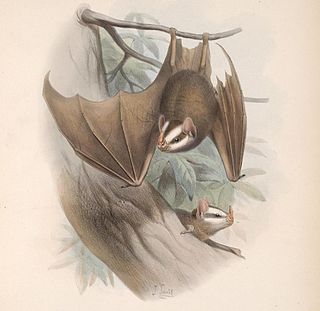
Chiroderma – big-eyed bats or white-lined bats – is a genus of leaf-nosed bat found in North America, Central America, and South America and the Lesser Antilles.
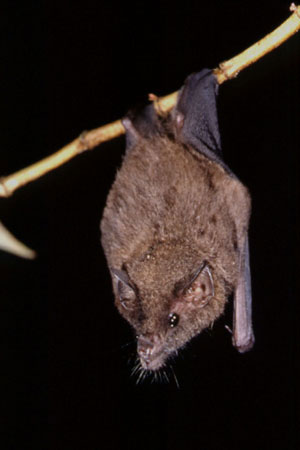
Anoura is a genus of leaf-nosed bats from Central and South America. Anoura members lack or have a short tail, and are nectarivorous bats of small to medium size among the Phyllostomidae.
The Guadeloupe big brown bat is a species of vesper bat. It is found only on the island of Guadeloupe. It is one of the eleven species of bat found on Guadeloupe, and one of three that are endemic.

Genoways's yellow bat is a species of vesper bat found only in Mexico. It is threatened by habitat loss. Due to its imperiled status, it is identified by the Alliance for Zero Extinction as a species in danger of imminent extinction.
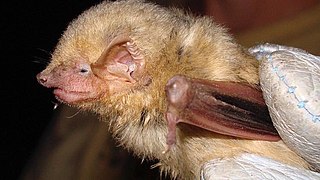
The western yellow bat is a species of vesper bat found in Mexico and the southwestern United States. This species roosts in trees such as Populus fremontii, Platanus wrightii, and Quercus arizonica. If available, the western yellow bat will use the dead fronds that encircle palm trees as a roosting site.
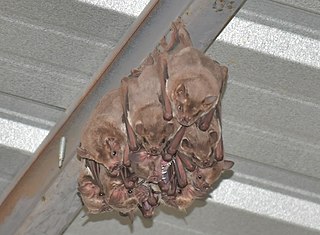
The fraternal fruit-eating bat is a species of bat in the family Phyllostomidae that is found in drier habitats in Ecuador and Peru. It was formerly considered to be a subspecies of the Jamaican fruit bat, but was raised to species level in 1978. The smallest species in the group of large Artibeus, it has a forearm length of 52–59 mm (2.0–2.3 in), a total length of 64–76 mm (2.5–3.0 in), and a weight of 30–55 g (1.1–1.9 oz).

Fernandez's sword-nosed bat is a species of bat in the family Phyllostomidae. It is the smallest species of the Lonchorhina genus. It is endemic to Venezuela. In 2013, Bat Conservation International listed this species as one of the 35 species of its worldwide priority list of conservation. It is threatened by habitat loss. It derives its scientific name from a Venezuelan zoologist, Dr. Alberto Fernandez Badillo, whose research focused on vampire bats, in particular.
The Thomas's yellow-shouldered bat is a species of bat in the family Phyllostomidae. It is endemic to Guadeloupe.
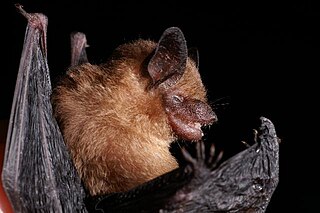
Rhogeessa is a genus of bats within the vesper bats family, Vespertilionidae.
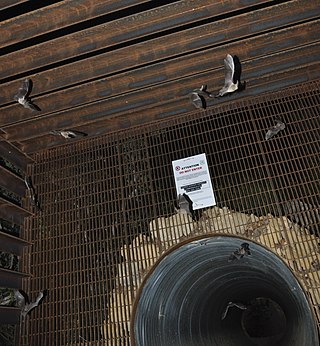
A maternity colony refers to a temporary association of reproductive female bats for giving birth to, nursing, and weaning their pups. The colonies are initiated by pregnant bats. After giving birth, the colony consists of the lactating females and their offspring. After weaning, juveniles will leave the maternity colony, and the colony itself will break apart. The size of a maternity colony is highly variable by species, with some species forming colonies consisting of ten or fewer individuals, while the largest maternity colony in the world in Bracken Cave is estimated to have over 15 million bats.
Chiroderma vizottoi is a species of frugivorous bat found in the northeast of Brazil.
Sturnira angeli, also known as the Guadeloupe yellow-shouldered bat or Angel's yellow-shouldered bat, is a species of bat in the family Phyllostomidae. It is endemic to the Lesser Antilles. As of 2018 it is listed as near threatened by the IUCN.
Paulson's yellow-shouldered bat is a species of bat in the family Phyllostomidae. It is endemic to the Lesser Antilles. According to the most recent IUCN analysis in 2019, it is near-threatened.














